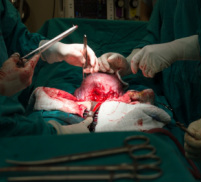
What's The Story?
The numbers don’t look much better on closer inspection either. The pattern is similar to that seen in last post (and the one before that actually); the older you are the worse your outcome is likely to be. The UK Emergency Laparotomy Network provides a rough approximation of risk. They describe that mortality for patients in their 50’s was around 10%, with this mortality increasing by 5% per decade. The worse outcomes in the elderly aren’t just limited to mortality either, with both post-operative complications rates and the chances of being discharged home being notably worse in the emergency group (88% vs 39% for complications and 69% vs 6.5% for discharge home).
Why The Difference?
The authors go on point out, with a few examples, that these may be patients in which medical therapy has been tried and failed, with surgery being postponed until further down the line when there has been more time for deterioration (e.g. failed endoscopic control of peptic ulcer disease, failed medical management of the acute colitis episode). They also return to this idea of the importance of critical care after these procedures and the tangible difference that it makes to the outcome of these patients, mainly by reducing or identifying the post-operative complications earlier. Trusts with a higher ratio of ICU beds to hospital beds have better 30-day mortality figures, and patients admitted directly to ICU having a reduced mortality compared with those going straight to the ward (30% compared with 38% in one reported study). They suggest that it might actually be these post-op complications (and there subsequent detection and management) that has the biggest impact on survival after such major surgery.
What Should We Do?
Pre-op:
- Early antibiotics in patients with concurrent sepsis (the sooner the better)
- Early diagnosis through senior, multi-disciplinary clinician assessment and CT scanning
- Early surgery, minimising delay as much as possible
- Invasive arterial blood pressure monitoring
- Core temperature monitoring and maintenance
- Use of near patient testing (notably for acid-base balance, haemoglobin concentration, and oxygen exchange)
- Goal directed fluid administration (more controversial)
- Consideration of epidural use (a risk-benefit decision)
- Critical care admission post-op (though obvious resource limitations)
- Implementation of appropriate ‘care-bundles’
Let's Summarise
The last point I wanted to cover was one that stood out for me from the authors’ analysis of assessing and preparing these patients for this major surgical procedure. Though they have gone into detail to point out how age is a major risk factor for adverse outcomes in these patients, they highlight that 70% of patients aged over 90 do survive until (at least) 30 days post surgery. One of the most common adverse events in patients with this range of pathology was looking back and feeling that the operation should have gone ahead when it didn't.
Thanks once again for reading and I have tried to put together a list of a few more interesting resources to keep you busy until the grand finale of this trilogy .
Tom Heaton
www.rcoa.ac.uk - A link to some of the webcasts on the RCOA website with a few nice videos on emergency laparatomy
www.nela.org.uk - A link to the home page of the NELA group.
 RSS Feed
RSS Feed
